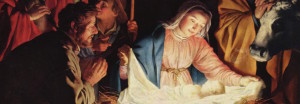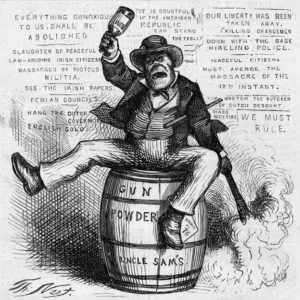 In all my years here at Saint John, I do not think I have ever missed a week of this chance to communicate with you about the positive (and sometimes not so positive) environment of our Parish Family and our impact on the community and the world. I hope to never do so. Other than Our Holy Father and Father John, I have also never relinquished this space for another voice. Father John mentioned an incident in Mass last weekend, detailing how a group of volunteers who were assisting our Jamaica Outreach Project were verbally accosted in our Prayer Garden because they were saying the Rosary in Spanish. Now more than ever, we need to stand together as a faith and a community in support of each and every one of us.
In all my years here at Saint John, I do not think I have ever missed a week of this chance to communicate with you about the positive (and sometimes not so positive) environment of our Parish Family and our impact on the community and the world. I hope to never do so. Other than Our Holy Father and Father John, I have also never relinquished this space for another voice. Father John mentioned an incident in Mass last weekend, detailing how a group of volunteers who were assisting our Jamaica Outreach Project were verbally accosted in our Prayer Garden because they were saying the Rosary in Spanish. Now more than ever, we need to stand together as a faith and a community in support of each and every one of us.
The Holy Spirit must be at work, because Joe Boland, Vice President of Mission, of the organization Catholic Extension, put out a story just this past week that goes to the core of our message. Even more appropriately, his message, entitled Five Timely Lessons from Our Immigration History, focuses on the Irish and Italian cultural history in America, which we are celebrating this weekend at our Gaelic and Garlic Festival. I thought I would let his words speak for themselves:
St. Patrick’s Day and St. Joseph’s Day are fast approaching. These two feast days continue to be big celebrations for two Catholic ethnic groups that flocked to our American shores as immigrants in large numbers over the last two centuries: the Irish and the Italians. When the Irish mark St. Paddy’s Day and the Italians honor St. Joe, they celebrate not only their Catholic faith but also their national heritage.
This year especially, before we unthinkingly put on our green shirts for the Irish on March 17 or our red sweaters for the Italians on March 19 or 20, we should pause to remember the past and the lessons it teaches us.
While it seems cliché to say that “history repeats itself,” these two feasts evoke very real and very unkind memories of what our immigrant ancestors endured. Their tenuous status in a new land was strikingly similar to what immigrants experience today.
The Catholic Church in America has always been and continues to be a largely immigrant Church. The organization I work for, Catholic Extension, has an enormous stake and interest in this important conversation. Since 1906, Extension has been building and supporting the growth of the Catholic Church in America. In those 111 years, we have built almost 12,500 churches throughout this great country — whether for Irish immigrant mining communities in the 1910s or for Latino immigrant farmworkers in the 2010s.
In the past five years alone, Catholic Extension has invested $7 million dollars in programs that provide direct outreach to immigrants and refugees throughout the country. Since its founding, Catholic Extension has granted $120 million to the Catholic Church located in the U.S.-Mexico border region, a place that is home today to more than 4 million Catholics, who include sun-seeking retirees from the North, Native Americans, immigrants, and the descendants of immigrants. We serve them all.
On this year’s feast days of St. Patrick and St. Joseph, let us take a stroll down a less-than-rosy memory lane to see how some of yesterday’s immigrant groups were greeted as they fled their countries. Perhaps this historical remembrance can shed new light on our current national discussions and attitudes about immigrants and immigration.
Lesson #1 – Do not forget that St. Joseph, Mary and Jesus were a refugee family
 We start this history lesson by going back to the very beginning of our story as a Christian people, by looking at the life of St. Joseph and the family entrusted to his care.
We start this history lesson by going back to the very beginning of our story as a Christian people, by looking at the life of St. Joseph and the family entrusted to his care.
St. Joseph was a dreamer who listened to the angel’s warning in his dreams to take the child Jesus to safety in Egypt. The Holy Family became refugees trying to escape King Herod’s jealous violence in their homeland. Jesus, whose life was saved by this flight into Egypt, in turn, became a DREAMER in the modern sense — someone whose parents took him to a foreign country as a small child. The scriptures do not tell us whether Joseph had secured the proper visa paperwork before taking his entire family across borders to Egypt.
Perhaps it was Jesus’ own experience as a vulnerable child refugee that helped shape his teaching in the Gospel of Matthew, when he proclaimed, “Whatever you did for one of these least brothers of mine, you did for me” (25:40).
On February 14, 20 Catholic bishops from the southern U.S. border region signed on to a powerful joint pastoral letter that began by recalling that the Holy Family was a refugee family, not unlike many of the people fleeing violence today. This biblical event has moral implications for us today. Therefore, the border bishops state, “As a Church we reiterate our commitment to care for pilgrims, strangers, exiles, and migrants affirming that all persons have a right to live in conditions worthy of human life.”
Lesson #2 – Remember that you, too, were once strangers in a strange land (Exodus 23:9)
 A Harper’s Weekly cartoon from 1871 depicts a savage-looking Irish immigrant whose lawless ways threaten to destroy the United States. Holding a bottle of booze in one hand and a torch in the other, he is about to carelessly light a keg of “Uncle Sam’s Gun Powder,” terminating our country.
A Harper’s Weekly cartoon from 1871 depicts a savage-looking Irish immigrant whose lawless ways threaten to destroy the United States. Holding a bottle of booze in one hand and a torch in the other, he is about to carelessly light a keg of “Uncle Sam’s Gun Powder,” terminating our country.
The article accompanying this cartoon encouraged its readers to defend their country against the immigrant aggressor, saying “Should the Orangemen ever parade in New York, let the citizens who feel aggrieved at the violation of our laws and institutions take whatever measures they choose into their hands to uphold the laws, if they care anything about their country.” Translation? Be a patriot by defending against the un-American Irish.
In a January 29 statement, Bishop Anthony Taylor, who leads the largely immigrant Diocese of Little Rock, Arkansas, said, “You and I are children of immigrants who were not much different from those of today. Our ancestors came here because they saw the United States as a beacon of hope, a place to escape the poverty and tyranny of the Old World, … and they are the ones who made our nation great.” He went on to say that those “who persecuted the Irish Catholic potato famine immigrants of the 1850s, they made our nation small.”
More at: https://www.catholicextension.org/stories/five-timely-lessons-our-immigration-history
I hope we can all enjoy Gaelic and Garlic this weekend as a celebration of our shared heritage and culture, knowing that we who were welcomed are now able to welcome others into our church and into our society.
